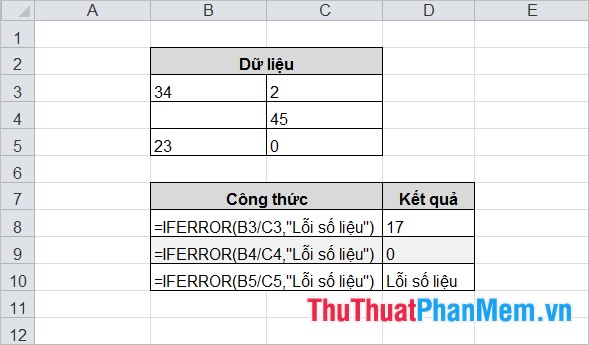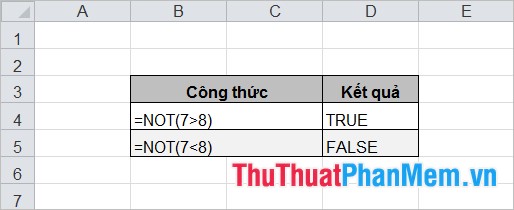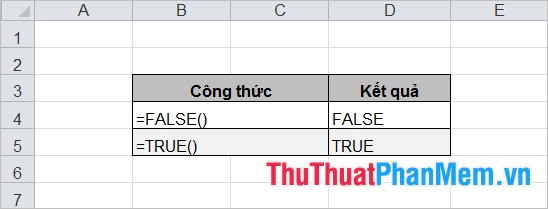Logical functions (logical) in Excel
Logical functions are used a lot during data processing in Excel. If you do not know all of the common logical functions, follow the article below. The article summarizes the syntax and functions of functions in logical function groups in Excel.

1. AND
Syntax:
= AND (logical1, logical2, .)
Inside:
- logical1, logical2, . is one or more logical expressions that can be TRUE or FALSE.
Description:
The function returns TRUE if all arguments are evaluated as TRUE and returns FALSE if one or more logical values are defined as FALSE.
For example:

2. IF
Syntax:
= IF (logical_test, value_if_true, value_if_false)
Inside:
- logical_test: any value or expression that can be TRUE or FALSE.
- value_if_true: is the value you want to return when logical_test is TRUE. If logical_test is TRUE and value_if_true is omitted, the function will return 0 (zero).
- value_if_false: is the value that you want to return when logical_test is FALSE. If logical_test is FALSE where value_if_false is omitted (without the comma after the value_if_true argument), the function returns the logical value FALSE. If logical_test is FALSE where value_if_false is omitted (comma is followed by value_if_true argument), the function returns 0 (zero).
Description:
The function returns a value if the condition you specified is TRUE and returns a different value if that condition is evaluated as FALSE.
For example:

3. IFERROR
Syntax:
= IFERROR (value, value_if_error)
Inside:
- value: expression to check for errors.
- value_if_error: return value if value error, the following error types: # N / A, #VALUE, #REF, # DIV / 0 !, #NUM !, #NAME? or #NULL !.
Description:
The function returns the value_if_error if the value is evaluated as an error, otherwise the result of the formula is returned.
For example:

4. NOT
Syntax:
= NOT (logical)
Inside:
logical is an expression, a condition of type logic.
Description:
The function that returns the result is a negation of the logical expression, NOT returns TRUE if the logical expression is FALSE and vice versa.
For example:

5. OR
Syntax:
= OR (logical1, logical2, .)
Inside:
- logical1, logical2, . are the expressions and conditions that you want to check TRUE or FALSE.
Description:
The function returns TRUE if one or more logical is TRUE, returns FALSE if all logical is FALSE.
For example:

6. FALSE () and TRUE ()
Syntax:
= FALSE () = TRUE ()
No arguments. You can enter FALSE or TRUE directly into a formula or function when calculating. Excel will interpret itself as a logical value of FALSE or TRUE value.
For example:

The article has introduced to you the functions in the logical function group in Excel, hope the article will help you. Good luck!
You should read it
- VAR.P function - Function that calculates variance based on the entire set, ignoring logical values and text in Excel
- How to use the IFS function in Excel 2016
- IFERROR function in Excel, formulas, and usage
- MINA and MAXA functions in Excel
- How to create and delete tables in Excel
- Answering these 10 puzzles in 7 seconds proves that your brain is extremely special!
- Shell functions
- VARA - Function that calculates variance based on a sample, including logical values and text in Excel
May be interested
- VAR.S function - Function that calculates variance based on a sample, ignoring logical values and text in Excel
 var.s function: function that calculates variance based on a sample, ignoring logical values and text. support functions from excel 2010 onwards. syntax: var.s (number1, [number2], ...)
var.s function: function that calculates variance based on a sample, ignoring logical values and text. support functions from excel 2010 onwards. syntax: var.s (number1, [number2], ...) - VAR.P function - Function that calculates variance based on the entire set, ignoring logical values and text in Excel
 var.p function: function that calculates variance based on the entire set, ignoring logical values and text. support functions from excel 2010 onwards. syntax: var.p (number1, [number2], ...)
var.p function: function that calculates variance based on the entire set, ignoring logical values and text. support functions from excel 2010 onwards. syntax: var.p (number1, [number2], ...) - Comparison functions in Excel - How to use comparison functions and examples using comparison functions
 comparison functions in excel - how to use comparison functions and examples using comparison functions with a large amount of data, you want to check for duplicates by checking normally, it is really hard. in this article, introduce to you the functions
comparison functions in excel - how to use comparison functions and examples using comparison functions with a large amount of data, you want to check for duplicates by checking normally, it is really hard. in this article, introduce to you the functions - Date time functions in Excel
 excel supports you to process and calculate quickly with the functions that excel provides such as calculation functions, date functions ... one of them is the function of time to help you handle the prices. time value: hour, minute, second conveniently
excel supports you to process and calculate quickly with the functions that excel provides such as calculation functions, date functions ... one of them is the function of time to help you handle the prices. time value: hour, minute, second conveniently - IFERROR function in Excel, formulas, and usage
 the iferror function in excel corrects a formula error, returning a different value that replaces the error message in the normal way.
the iferror function in excel corrects a formula error, returning a different value that replaces the error message in the normal way. - 10 EXCEL functions that ACCOUNTERS often use
 in excel, there are many functions that can help accounting in daily data entry, but here are some common functions used by accounting.
in excel, there are many functions that can help accounting in daily data entry, but here are some common functions used by accounting. - The 10 most useful but often forgotten functions in excel
 microsoft excel is an extremely effective and effective calculation tool not only for accounting and office but also for many other industries.
microsoft excel is an extremely effective and effective calculation tool not only for accounting and office but also for many other industries. - How to use Excel's VALUE function
 excel's value function will convert a string to a digital form, which can be combined with other functions such as left function, right function, mid function.
excel's value function will convert a string to a digital form, which can be combined with other functions such as left function, right function, mid function. - Instructions for using Index function in Excel
 index is a function that returns an array in excel. when using the index function, you get the values in a cell between the column and the row.
index is a function that returns an array in excel. when using the index function, you get the values in a cell between the column and the row. - Tips for working with functions in Excel
 functions that work with excel functions functions are predefined formulas for performing specific calculations, or for manipulating spreadsheets.
functions that work with excel functions functions are predefined formulas for performing specific calculations, or for manipulating spreadsheets.










 Spacing, spacing words in Word
Spacing, spacing words in Word How to use the RANK function in Excel
How to use the RANK function in Excel Change the width of columns and the height of rows in Excel
Change the width of columns and the height of rows in Excel Daverage function in Excel - Daverage function calculates the average value with a given condition
Daverage function in Excel - Daverage function calculates the average value with a given condition IF function in Excel
IF function in Excel Split data in columns in Excel
Split data in columns in Excel